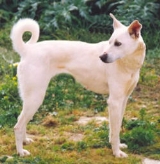
Cretan Hound
Encyclopedia
A Kritikos Ichnilatis (Cretan Hound) (Greek:Kρητικός Iχνηλάτης) is a hunting breed
of dog
from the island of Crete
, in Greece
. It is considered
to be one of the oldest hunting breeds in Europe
, with a history that goes back to 4,000 years ago.
This is a multi-talented dog that comes directly from Crete. It has excellent scent, speed, agility, durability, that make it an exceptional hare hunter. Cretan Hounds also have guarding instincts as well as pastoral instincts.
The dog is slightly longer than tall, with medium angulations, slender legs and good muscle; the ribcage is spacious but neither too broad nor too rounded and it does not quite reach the point of elbow. The loin is slender yet powerful and there is good tuck-up, with the points of the hipbones slightly prominent. There should be a balance between characteristics of speed and stamina, the conformation being a compromise producing great agility. Flabby, clumsy, heavy individuals not to be tolerated.
The colors of this breed can range from: pure white, cream, sandy, fawn, grey, black or brindle, bi-colored or tri-colored.
Sizes:
Males: 27 inches or more (60+cm)
Females: 19+ inches (50+ cm)
Weight for both males and females can be between 44-66 pounds (20–30 kg).
Slightly reserved with strangers, it’s naturally inquisitive and tolerant. The Cretan Hound lives happily together with other domestic animals but will ruthlessly chase the neighbor’s cat! Excellent, gentle and very affectionate with children. It rarely barks but will give notice of strangers approaching its home; at the farm it will kill mice and rats and it’s not indifferent to feathered game, but the latter use will make the breed lazy and untidy in the hunt; its constitution needs the challenge of the true chase.
Dog breed
Dog breeds are groups of closely related and visibly similar domestic dogs, which are all of the subspecies Canis lupus familiaris, having characteristic traits that are selected and maintained by humans, bred from a known foundation stock....
of dog
Dog
The domestic dog is a domesticated form of the gray wolf, a member of the Canidae family of the order Carnivora. The term is used for both feral and pet varieties. The dog may have been the first animal to be domesticated, and has been the most widely kept working, hunting, and companion animal in...
from the island of Crete
Crete
Crete is the largest and most populous of the Greek islands, the fifth largest island in the Mediterranean Sea, and one of the thirteen administrative regions of Greece. It forms a significant part of the economy and cultural heritage of Greece while retaining its own local cultural traits...
, in Greece
Greece
Greece , officially the Hellenic Republic , and historically Hellas or the Republic of Greece in English, is a country in southeastern Europe....
. It is considered
to be one of the oldest hunting breeds in Europe
Europe
Europe is, by convention, one of the world's seven continents. Comprising the westernmost peninsula of Eurasia, Europe is generally 'divided' from Asia to its east by the watershed divides of the Ural and Caucasus Mountains, the Ural River, the Caspian and Black Seas, and the waterways connecting...
, with a history that goes back to 4,000 years ago.
This is a multi-talented dog that comes directly from Crete. It has excellent scent, speed, agility, durability, that make it an exceptional hare hunter. Cretan Hounds also have guarding instincts as well as pastoral instincts.
Appearance
The Cretan Hound is a slender dog, somewhere in the middle between a scenthound and a sighthound in body, particularly light on its feet (that are oval rather than cat-like) and strong in loin, specially adopted for swift reflexes and high speed over dangerous, rocky terrain. The head is wedge-shaped, elongated and dry, with pricked and very mobile ears that fold backwards like a greyhound’s during the chase. The tail is a most important breed characteristic: long and curved upwards, forming a loose or tight ring and covered with a brush of longer hair underneath.The dog is slightly longer than tall, with medium angulations, slender legs and good muscle; the ribcage is spacious but neither too broad nor too rounded and it does not quite reach the point of elbow. The loin is slender yet powerful and there is good tuck-up, with the points of the hipbones slightly prominent. There should be a balance between characteristics of speed and stamina, the conformation being a compromise producing great agility. Flabby, clumsy, heavy individuals not to be tolerated.
The colors of this breed can range from: pure white, cream, sandy, fawn, grey, black or brindle, bi-colored or tri-colored.
Sizes:
Males: 27 inches or more (60+cm)
Females: 19+ inches (50+ cm)
Weight for both males and females can be between 44-66 pounds (20–30 kg).
Temperament
The Cretan Hound uses both sight and scent on the hunt and they have a particular tendency to taste the aerial or ground scent, even to the point of sucking it from pebbles and stones. When the prey is sensed, the tail moves in circular fashion and the hound becomes rigid, moments before the chase begins. Meek, affectionate, aristocratic, yet deadly on the chase, it’s a polite hound that comes alive in the presence of prey; clean, gentle, elegant in form and movement, it’s never vulgar or overwhelming in gestures.Slightly reserved with strangers, it’s naturally inquisitive and tolerant. The Cretan Hound lives happily together with other domestic animals but will ruthlessly chase the neighbor’s cat! Excellent, gentle and very affectionate with children. It rarely barks but will give notice of strangers approaching its home; at the farm it will kill mice and rats and it’s not indifferent to feathered game, but the latter use will make the breed lazy and untidy in the hunt; its constitution needs the challenge of the true chase.

